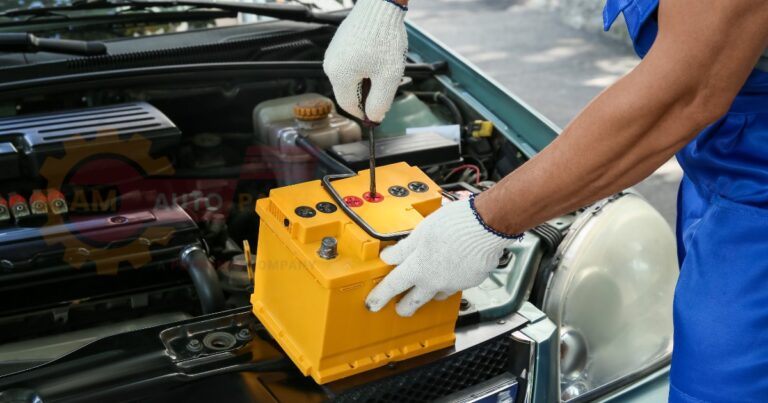Is your car’s battery a ticking time bomb? Most drivers don’t realise the vehicle breakdowns, safety hazards, and repair bills that could be lurking under the hood if that crucial component fails. And with Dubai’s scorching heat that can tax even the sturdiest batteries, could yours leave you stranded?
This guide tackles everything vehicle owners in the UAE need to know about car battery health.
What is a Car Battery?
A lead-acid car battery provides electric energy to power your vehicle’s starter motor, ignition system, engine control computer, lights, audio system, and other accessories. Inside the battery, chemical reactions occur between lead plates and sulfuric acid to produce and store electricity.
A healthy battery should have a voltage reading of 12.6 to 12.8 volts when fully charged. Over time, batteries lose their ability to hold a charge due to use, heat damage, sulfation buildup, or other issues. Monitoring battery health and addressing problems early helps avoid being stranded with a dead battery.
Signs of a Failing or Unhealthy Battery
Watch for these common warning signs that your car battery is failing or unhealthy:
- Difficulty starting the engine or a lagging starter
- Dimming or flickering lights, especially when idling
- Battery warning light illuminated on the dash
- Corroded or loose battery cables
- Cracked battery case or cover
- Unusual smells near the battery
- Battery more than 3 years old
How to Test Your Car Battery
You can easily test your car battery to check overall health and voltage. Turn off all electronics and lights first. Then, use a battery tester or multimeter to measure voltage. Compared to the ideal reading of 12.6 to 12.8 volts when fully charged. Lower voltage indicates capacity loss, while higher suggests overcharging.
Many auto parts stores offer free battery testing to check voltage, cranking power, and overall condition. This is recommended annually or with any charging system problems.
Maintaining Proper Battery Charge
The key to maximising car battery life is keeping your battery properly charged. Driving 15-20 minutes per day usually provides sufficient charging, but shorter trips may not fully charge the battery. Consider using a battery tender or trickle charger if you have infrequent driving patterns.
Check the battery and charging system whenever you experience hard starting issues. Continuing to crank a weak battery will only further discharge it. Identifying and resolving charging problems quickly can help avoid battery failure.
Cleaning Battery Terminals and Cables
Corrosion on the battery terminals or inside the cable ends can prevent proper electrical contact. Use a wire brush to scrub buildup off the terminals and inside cable clamps. Clean surfaces thoroughly until shiny metal is exposed, then reconnect cables and coat terminals with dielectric grease or anti-corrosion spray.
| Condition | Cleaning Frequency |
| Minimal corrosion | Every 6-12 months |
| Moderate corrosion | Every 3-6 months |
| Severe corrosion | Every 1-3 months |
| Frequent short trips | More frequent cleaning may be needed. |
| Extreme weather conditions | More frequent cleaning may be needed. |
This table provides recommendations on how often you should clean your battery terminals and cables based on different conditions. Regular maintenance is key, especially in extreme weather or if you frequently make short trips.
Checking Battery Age and Condition
Most standard car batteries last 3-5 years, depending on use, climate, and maintenance. The sticker on top indicates the manufacture date. If your battery is over 3 years old, have it tested to check overall condition and performance.
Inspect the battery case and cover for any cracks or damage, too. A white powdery substance on top may indicate acid seepage and internal damage. Replace batteries immediately that show signs of leakage or cause damage.
| Test Result | Interpretation |
| 12.6V or higher | The battery is fully charged and in good condition. |
| 12.4V to 12.6V | The battery is partially charged or slightly weak. |
| Below 12.4V | The battery is discharged and may need charging or replacement. |
This table explains how to interpret the results of a battery load test. This test helps assess the actual health and performance of the battery.
Battery Voltage vs. Temperature
| Temperature (°C) | Ideal Battery Voltage (12V System) |
| Below freezing (-18°C) | 12.6V or higher |
| 0°C (32°F) | 12.4V or higher |
| 26.7°C (80°F) | 12.2V or higher |
| 37.8°C (100°F) | 12.0V or higher |
This table provides information on the ideal battery voltage for different temperatures. It helps you understand how temperature affects battery performance.
When to Replace Your Car Battery
If your battery shows signs of failure like slow cranking, inability to hold a charge, or voltage consistently below 12.4 volts, replacement is likely needed. Likewise, replace immediately if you find a cracked case or acid leakage.
For preventive maintenance, proactively replace your battery every 3-4 years. Choosing AGM or lithium types can also extend overall service life. Our battery replacement services use premium batteries for reliable starts. Automotive electrical measurement helps check if car parts that use electricity are working right It uses special tools to test things like batteries wires and lights in vehicles
Choosing the Right Replacement Battery
When buying a new battery, match replacement specs to OEM size, type, and CCA rating for proper fit and performance. Upgrading to an AGM or lithium battery adds cold cranking amps (CCA) and extended service life. We offer premium AGM and lithium replacements that fit your exact vehicle.
Proper Battery Installation Tips
Taking care when installing your new battery prevents accidental damage:
- Always disconnect the negative cable first and reconnect it last to avoid short circuits
- Ensure vent caps are tight to prevent acid seepage
- Coat terminals with dielectric grease or anti-corrosion spray
- Securely mount the battery and tighten hold-downs to avoid vibration damage
- Double-check cable routing to prevent chafing or rubbing
With proper installation and care, your new battery should provide reliable starts for years. Our skilled technicians take extra care when fitting new batteries in our shop.
Cold Weather Battery Tips
Battery output and cranking ability decrease in cold temperatures. But taking steps to protect your battery from extreme cold allows proper starting during winter:
- Fully charge the battery before winter and monthly during the cold season
- Store the vehicle in the garage when possible to limit exposure
- Upgrade to AGM or lithium battery for increased cold-cranking amps
- Check voltage and load test before winter; replace weak batteries
- Allow the engine to warm before driving to prevent recharge overload
Signs of an Overcharged Battery
Overcharging your battery too frequently creates excess heat and gassed fluid loss. Watch for these red flags:
- The battery feels hot to the touch after driving
- Rapid water loss requiring frequent refilling
- Bubbling, hissing or gurgling sounds
- Melted battery terminals or casings
- Battery service life reduced to 12-24 months
Check your charging system anytime overcharging symptoms arise. A faulty voltage regulator, alternator, or battery may require replacement to prevent damage.
How to Prevent Sulfation Buildup
Hard sulphur crystals (sulfation) coating the lead battery plates commonly cause premature failure. Sulfation prevents the chemical reactions that produce electricity, resulting in a shortened service life.
You can minimise sulfation buildup by:
- Fully charging battery monthly or after each use
- Avoiding deeply discharging the battery
- Using a desulfation charger periodically
- Checking acid levels and refilling with distilled water as needed
- Upgrading to AGM batteries that resist sulfation
Early sulfation can often be reversed with proper charging. However, excessive buildup will require replacement.
Conclusion
Monitoring car battery health through routine testing and visual inspections allows you to address problems early. Maintaining proper charge levels, cleaning connections, and upgrading weak or older batteries as needed will ensure you have reliable starts.
Implementing cold weather battery protection steps and preventing overcharging or sulfation buildup protects battery life and performance. Your battery should deliver years of trouble-free starts with proper care and maintenance.
Contact our expert team for professional battery testing and replacement services to keep your car powered up.






